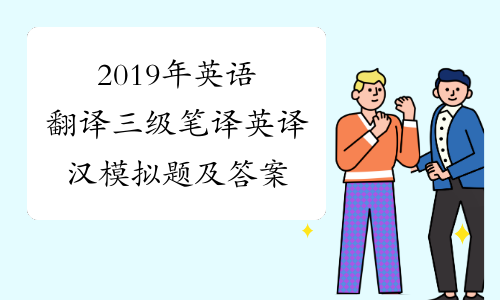2019年英语翻译三级笔译英译汉模拟题及答案
【摘要】 翻译网权威发布2019年英语翻译三级笔译英译汉模拟题及答案,更多2019年英语翻译三级笔译英译汉模拟题及答案相关信息请访问英语翻译资格考试
 翻译网权威发布2019年英语翻译三级笔译英译汉模拟题及答案,更多2019年英语翻译三级笔译英译汉模拟题及答案相关信息请访问英语翻译资格考试网。
翻译网权威发布2019年英语翻译三级笔译英译汉模拟题及答案,更多2019年英语翻译三级笔译英译汉模拟题及答案相关信息请访问英语翻译资格考试网。When night falls in remote parts of Africa and the Indian subcontinent, hundreds of millions of people without access to electricity turn to candles or kerosene lamps for illumination.
Slowly through small loans for solar powered devices, microfinance is bringing light to these rural regions where a lack of electricity has stemmed economic development, held down literacy rates and damaged health.
“Earlier, they could not do much once the sun set. Now, the sun is used differently. They have increased their productivity, improved their health and socio-economic status,” said Pinal Shah from SEWA Bank, a micro-lending institution.
Vegetable seller Ramiben Waghri took out a loan to buy a solar lantern which she uses to light up her stall at night. The lantern costs between $66-$112, about a week’s income for Waghri. “The vegetables look better by this light, and it’s cheaper than kerosene and doesn’t smell,” said Waghri, who estimates she makes about 300 rupees ($6) more each evening with her lantern. “If we can use the sun to save some money, why not?”
In India, solar power projects, often funded by micro credit institutions, are helping the country reduce carbon emissions and achieve its goal to double the contribution of renewable energy to 6%, or 25,000 megawatts, within the next four years.
Off-grid applications such as solar cookers and lanterns, which can provide several hours of light at night after being charged by the sun during the day, will help cut dependence on fossil fuels and reduce the fourth biggest emitter’s carbon footprint, said Pradeep Dadhich, a senior fellow at energy research institute TERI in India“ They are reaching people who otherwise have limited or no access to electricity and depend on kerosene, diesel or firewood for their energy need,” he said. “The appliances not only satisfy these needs, they also improve the quality of life and reduce the carbon emissions.”
SEWA, or the Self-Employed Women’s Association, is among a growing number of microfinance institutions in India focused on providing affordable renewable energy sources to poor people, who otherwise would have had to stand for hours to buy kerosene for lamps or trudge kilometers to collect firewood for cooking.
SKS, Microfinance, the largest such institution in India, offers solar lamps to its 5 million customers, while the Rural Solar Electricity Foundation helps pay for lamps and systems for homes and street lighting for villagers in India, Nepal and Bangladesh.
In neighboring Bangladesh, the state-owned and private-sector power plants can generate 3,700 to 4,300 megawatts of electricity a day against a demand of 5,500 megawatts, according to the state-run power development board. With only 40 percent of the country’s people having access to electricity, microfinance institutions like Grameen Bank have made a major push toward expanding the use of solar power. Since 2001, 350,000 solar home systems have been installed in Bangladesh and 550,000 solar lanterns have been distributed, bringing solar power to about 4 million people.
“Right now 2.5million people are benefiting from solar energy, and we have a plan to reach 10 million people by the end of 2012,” said Dipal Chandra Barua, managing director of Grameen Shakti, an offshoot of the 2006 Nobel Peace Prize winner Grameen Bank, which encourages the use of alternative energy.
参考答案
在印度次大陆的边远地区,当夜幕降临的时候,数亿人用不上电,靠蜡烛或煤油灯照明。用小额短期贷款购买太阳能装置,小额借贷渐渐地给这些农村地区带来了光明。缺点一直阻碍着那些地方的经济发展,限制了识字率的提高,损害了人们的健康。
赛瓦银行是一家小额信贷机构,其工作人员皮纳·沙赫说,“早先,太阳一落山,人们就干不了多少事了。现在,采取不同的方法来利用太阳,人们提高了生产力,改善了健康状况,提高了社会经济地位。”
拉米本·瓦格里是一个菜贩,她贷款购买了一盏太阳能灯,夜晚挂在菜摊上照明。一盏太阳能灯标价66至112美元,大约是瓦格里女士这样的人一周的收入。瓦格里女士说:“这盏灯一照,蔬菜显得更新鲜了,而且这还比用煤油便宜,也没什么气味。”她估计,有了这盏灯,她每晚可多挣300卢比,合6美元。她说:“要是能用太阳省点钱,干嘛不呢?”
在印度,太阳能项目往往能得到小额信贷机构的资助,这些项目正帮助这个国家减少碳排放,并在未来4年内实现使可再生能源的贡献率翻一番的目标,即6%,合25,000兆瓦。
印度能源资源研究所(简称TERI)高级研究员普拉迪普·达迪奇称,不靠电网供电的电器,如太阳能灶和在白天吸收太阳能后可在夜间照明数小时之久的太阳能灯,将有助于减少对化石燃料的依赖。他还说:“许多人用不上电,或只能用少量的电,而用煤油、柴油或柴火满足其能源需求,现在他们也能用上这些电器了。这些电器不仅能满足他们的需求,还能提高他们的生活质量,减少碳排放量。”
个体经营妇女协会(简称SEWA)是印度日益增多的小额信贷机构之一,其工作重点是向穷人提供廉价的可再生能源,否则这些穷人只得排数小时的队去买煤油点灯,或跋涉几公里路去拾柴做饭。
SKS小额借贷公司是印度此类机构中最大的,它向500万客户提供太阳能灯,而农村太阳能电力基金会则为印度、尼泊尔和孟加拉国村民购买此类家庭用灯和街道照明系统付款。
国家电力发展局提供的数据,在邻国孟加拉,国营和私营发电厂每天能生产3700至4300兆瓦的电力,而每天的电需求量则是5500兆瓦。由于仅有40%的人能用上电,小额借贷机构如格拉民银行就大力推广利用太阳能。自2001年以来,已在孟加拉国安装了35万套家用太阳能设备, 提供了55万盏太阳能灯, 使约400万人用上了太阳能。
格拉民银行曾因提倡使用替代能源而荣获2006年诺贝尔和平奖, 其分支机构格拉民沙克蒂公司总裁迪帕.钱德拉.巴鲁亚说, “目前有250万人受益于太阳能,我们还有一个计划,到2012年底前要把太阳能推广至1000万人。”
相关文章推荐
最新文章
- 1 2021年8月CATTI备考阅读练习(8.9)
- 2 2021年8月CATTI备考阅读练习(8.10)
- 3 2021年8月CATTI备考阅读练习(8.11)
- 4 2021三级笔译CATTI练习:世卫组织总干事在国际奥委会上的主旨演讲(下)
- 5 2021三级笔译CATTI练习:世卫组织总干事在国际奥委会上的主旨演讲(上)
- 6 2021年英语三级笔译CATTI练习:王毅在中国—东盟建立对话关系30周年纪念研讨会开幕式上的致辞
- 7 2021年英语三级级笔译CATTI考试:传染病
- 8 2021年英语三级级笔译CATTI考试:数十年精准而持续的努力
- 9 2021年英语三级级笔译CATTI考试:抗疟药物
- 10 2021年英语三级级笔译CATTI考试:创新思维


